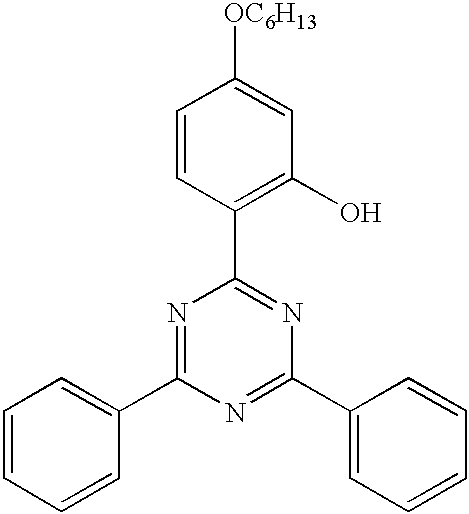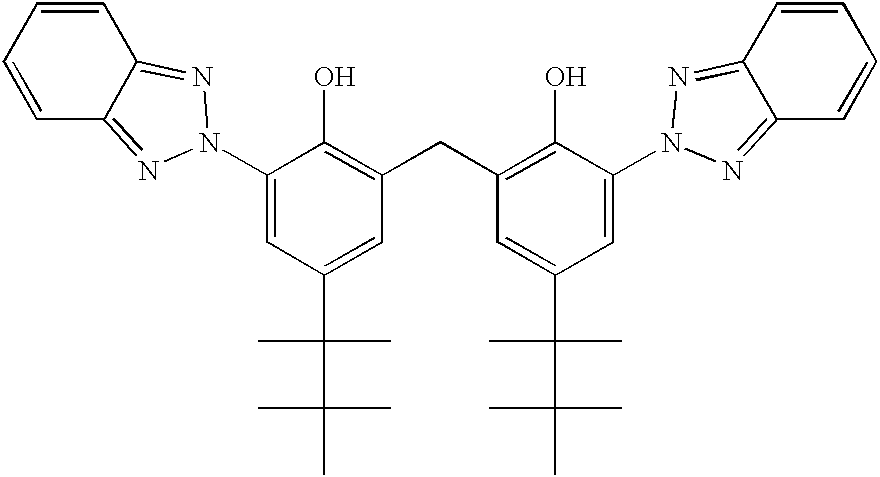Transparent, flame-retardant, thermoformable, UV-resistant film made from crystallizable thermoplastic, its use, and process for its production
a technology of crystallized thermoplastics and films, applied in the field of transparent, flame-retardant, thermoformable, uv-resistant films made from crystallized thermoplastics, can solve the problems of insufficient thermoformability, insufficient pre-drying effect, and insufficient thermoformability of films,
- Summary
- Abstract
- Description
- Claims
- Application Information
AI Technical Summary
Problems solved by technology
Method used
Image
Examples
example 1
A transparent film of 50 μm thickness is produced, comprising polyethylene terephthalate as principal constituent, 0.2% by weight of ®Sylobloc (silicon dioxide) as antiblocking agent, 4% by weight of the organophosphorus compound as flame retardant and 1.0% by weight of the UV stabilizer 2-(4,6-diphenyl-1,3,5-triazin-2-yl)-5-hexyloxyphenol (®Tinuvin 1577, from Ciba-Geigy). Tinuvin 1577 has a melting point of 149° C. and is thermally stable up to about 330° C.
To obtain homogeneous distribution, 0.2% by weight of Sylobloc is incorporated directly into the polyethylene terephthalate (PET) when the polymer is prepared.
The polyethylene terephthalate from which the transparent film is produced has a standard viscosity SV (DCA) of 810, corresponding to an intrinsic viscosity IV (DCA) of 0.658 dl / g. Both DEG content and PEG content are 1.6% by weight.
Tinuvin 1577 has a melting point of 149° C. and is thermally stable up to about 330° C.
The UV stabilizer Tinuvin 1577 is fed in the form of a ...
example 2
Coextrusion technology is used to produce a multilayer PET film having the layer sequence A-B-A and a thickness of 17 μm, B being the core layer and A being the outer layers. The core layer has a thickness of 15 μm, and each of the two outer layers which cover the core layer has a thickness of 1 μm.
The polyethylene terephthalate used for the core layer B is identical with the polymer of Example 1 except that it comprises no Sylobloc. The core layer comprises 0.2% by weight of hydrolysis stabilizer and 5% by weight of flame retardant. As in Example 1, the hydrolysis stabilizer and the flame retardant are fed in the form of a masterbatch. The masterbatch is composed of 25% by weight of flame retardant, 1% by weight of hydrolysis stabilizer and 74% by weight of polyethylene terephthalate. The flame retardant is identical with that used in Example 1. The hydrolysis stabilizer is pentaerythrityl tetrakis-3-(3,5-di-tert-butyl-4-hydroxyphenyl)propionate.
The polyethylene terephthalate of th...
example 3
As in Example 2, an A-B-A film of 20 μm thickness is produced, the core layer B having a thickness of 16 μm and each outer layer A having a thickness of 2 μm.
The core layer B comprises only 5% by weight of the flame retardant masterbatch of Example 2.
The outer layers are identical with those of Example 2, except that they additionally comprise 20% by weight of the flame retardant masterbatch, used in Example 2 only for the core layer.
The polymers and the masterbatches for the core layer and the outer layers are precrystallized, predried and post-dried as in Example 1.
The multilayer 20 μm film produced using coextrusion technology has the following property profile:
Layer structure:A-B-AThickness:20 μmSurface gloss Side 1:165(Measurement angle 20°) Side 2:169Light transmittance:92.0%Haze:2.5%Surface defects per m2:none(cracks, embrittlement)Longitudinal modulus of elasticity:3450 N / mm2Transverse modulus of elasticity:4000 N / mm2Longitudinal tensile strength at break:125 N / mm2Transverse...
PUM
| Property | Measurement | Unit |
|---|---|---|
| Fraction | aaaaa | aaaaa |
| Percent by mass | aaaaa | aaaaa |
| Percent by mass | aaaaa | aaaaa |
Abstract
Description
Claims
Application Information
 Login to View More
Login to View More - R&D
- Intellectual Property
- Life Sciences
- Materials
- Tech Scout
- Unparalleled Data Quality
- Higher Quality Content
- 60% Fewer Hallucinations
Browse by: Latest US Patents, China's latest patents, Technical Efficacy Thesaurus, Application Domain, Technology Topic, Popular Technical Reports.
© 2025 PatSnap. All rights reserved.Legal|Privacy policy|Modern Slavery Act Transparency Statement|Sitemap|About US| Contact US: help@patsnap.com


